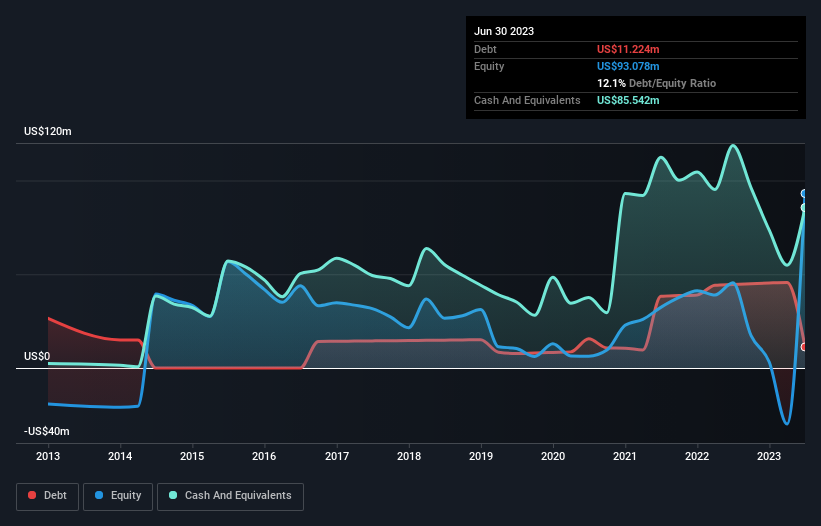Legendary fund manager Li Lu (who Charlie Munger backed) once said, 'The biggest investment risk is not the volatility of prices, but whether you will suffer a permanent loss of capital.' When we think about how risky a company is, we always like to look at its use of debt, since debt overload can lead to ruin. As with many other companies SCYNEXIS, Inc. (NASDAQ:SCYX) makes use of debt. But the more important question is: how much risk is that debt creating?
When Is Debt A Problem?
Debt assists a business until the business has trouble paying it off, either with new capital or with free cash flow. If things get really bad, the lenders can take control of the business. However, a more frequent (but still costly) occurrence is where a company must issue shares at bargain-basement prices, permanently diluting shareholders, just to shore up its balance sheet. By replacing dilution, though, debt can be an extremely good tool for businesses that need capital to invest in growth at high rates of return. When we think about a company's use of debt, we first look at cash and debt together.
Check out our latest analysis for SCYNEXIS
What Is SCYNEXIS's Debt?
The image below, which you can click on for greater detail, shows that SCYNEXIS had debt of US$11.2m at the end of June 2023, a reduction from US$44.6m over a year. But it also has US$85.5m in cash to offset that, meaning it has US$74.3m net cash.

How Healthy Is SCYNEXIS' Balance Sheet?
The latest balance sheet data shows that SCYNEXIS had liabilities of US$16.2m due within a year, and liabilities of US$45.6m falling due after that. Offsetting these obligations, it had cash of US$85.5m as well as receivables valued at US$46.6m due within 12 months. So it can boast US$70.4m more liquid assets than total liabilities.
This excess liquidity is a great indication that SCYNEXIS' balance sheet is almost as strong as Fort Knox. On this view, lenders should feel as safe as the beloved of a black-belt karate master. Simply put, the fact that SCYNEXIS has more cash than debt is arguably a good indication that it can manage its debt safely.
Although SCYNEXIS made a loss at the EBIT level, last year, it was also good to see that it generated US$62m in EBIT over the last twelve months. There's no doubt that we learn most about debt from the balance sheet. But it is future earnings, more than anything, that will determine SCYNEXIS's ability to maintain a healthy balance sheet going forward. So if you're focused on the future you can check out this free report showing analyst profit forecasts.
Finally, a company can only pay off debt with cold hard cash, not accounting profits. SCYNEXIS may have net cash on the balance sheet, but it is still interesting to look at how well the business converts its earnings before interest and tax (EBIT) to free cash flow, because that will influence both its need for, and its capacity to manage debt. In the last year, SCYNEXIS created free cash flow amounting to 17% of its EBIT, an uninspiring performance. For us, cash conversion that low sparks a little paranoia about is ability to extinguish debt.
Summing Up
While it is always sensible to investigate a company's debt, in this case SCYNEXIS has US$74.3m in net cash and a decent-looking balance sheet. So is SCYNEXIS's debt a risk? It doesn't seem so to us. The balance sheet is clearly the area to focus on when you are analysing debt. But ultimately, every company can contain risks that exist outside of the balance sheet. To that end, you should learn about the 3 warning signs we've spotted with SCYNEXIS (including 1 which can't be ignored) .
At the end of the day, it's often better to focus on companies that are free from net debt. You can access our special list of such companies (all with a track record of profit growth). It's free.
New: Manage All Your Stock Portfolios in One Place
We've created the ultimate portfolio companion for stock investors, and it's free.
• Connect an unlimited number of Portfolios and see your total in one currency
• Be alerted to new Warning Signs or Risks via email or mobile
• Track the Fair Value of your stocks
Have feedback on this article? Concerned about the content? Get in touch with us directly. Alternatively, email editorial-team (at) simplywallst.com.
This article by Simply Wall St is general in nature. We provide commentary based on historical data and analyst forecasts only using an unbiased methodology and our articles are not intended to be financial advice. It does not constitute a recommendation to buy or sell any stock, and does not take account of your objectives, or your financial situation. We aim to bring you long-term focused analysis driven by fundamental data. Note that our analysis may not factor in the latest price-sensitive company announcements or qualitative material. Simply Wall St has no position in any stocks mentioned.
About NasdaqGM:SCYX
SCYNEXIS
A biotechnology company, develops medicines to overcome and prevent difficult-to-treat and drug-resistant infections in the United States.
Medium-low risk with excellent balance sheet.
Market Insights
Community Narratives



